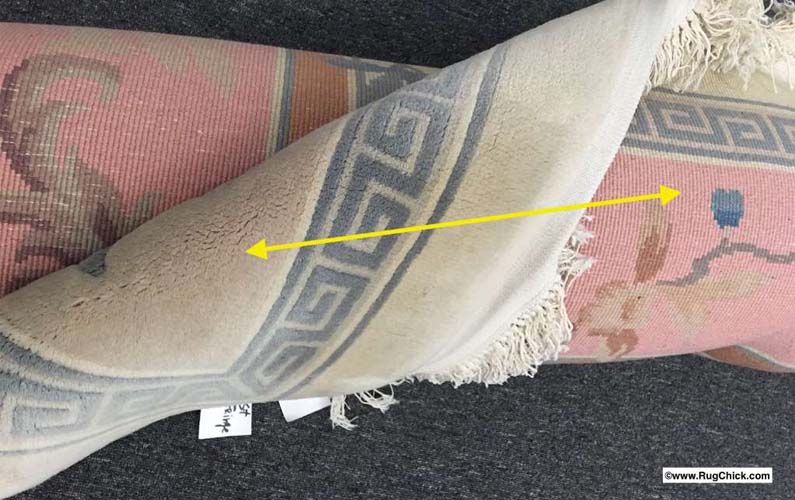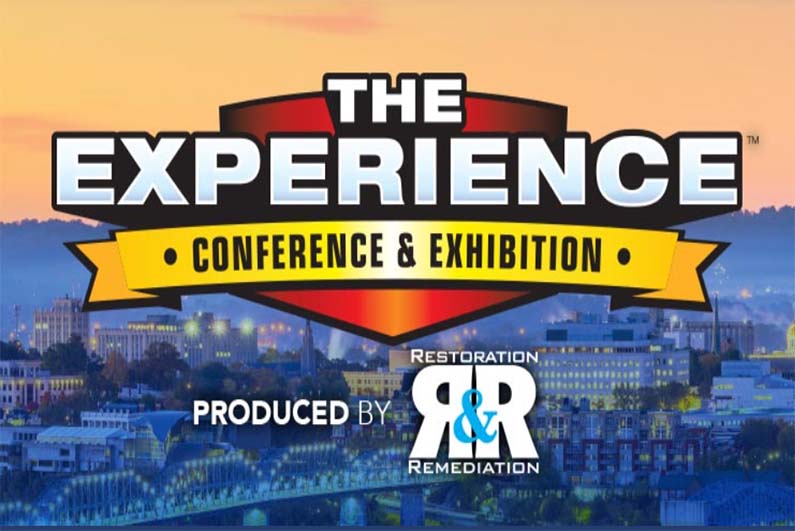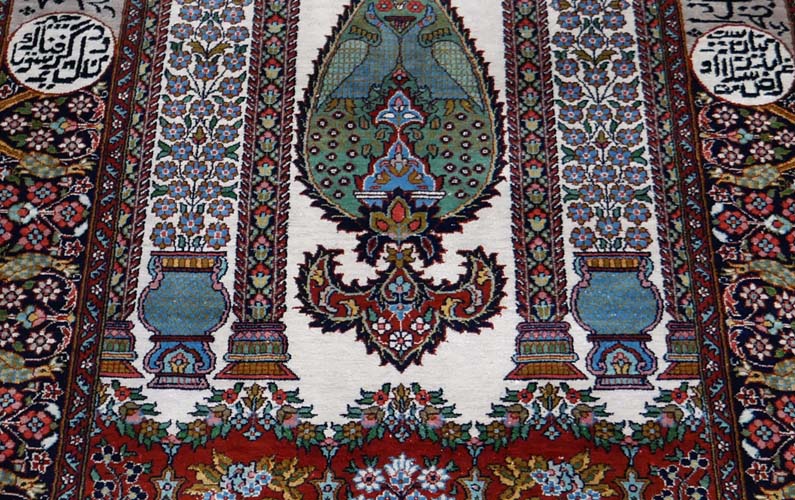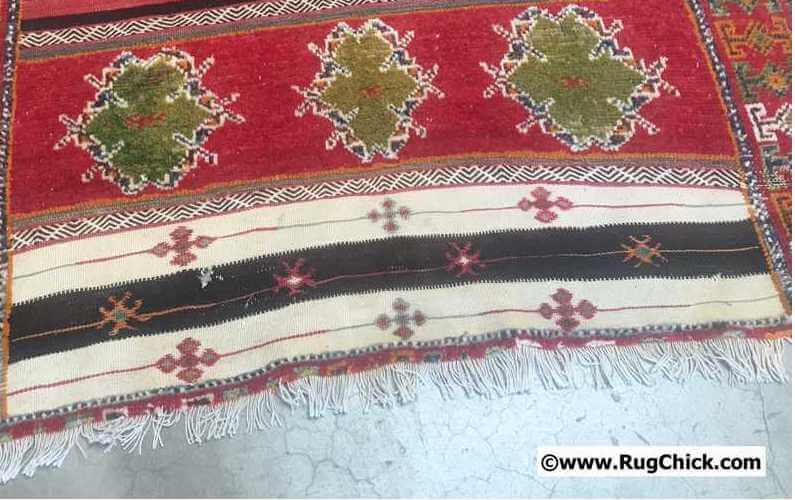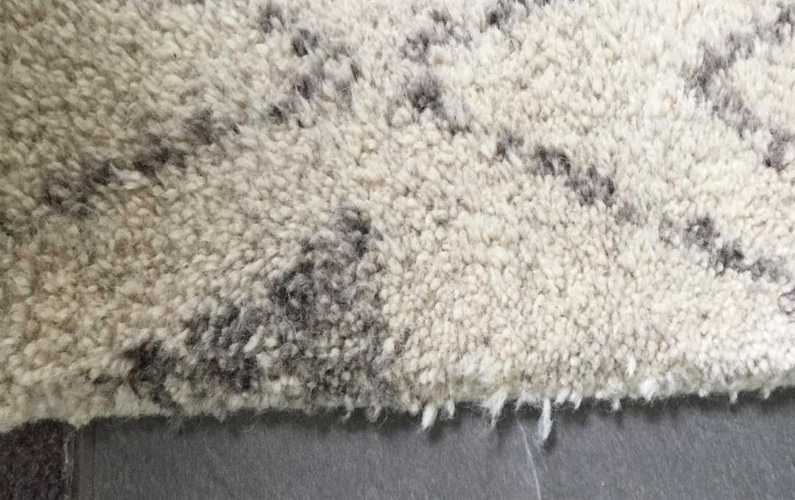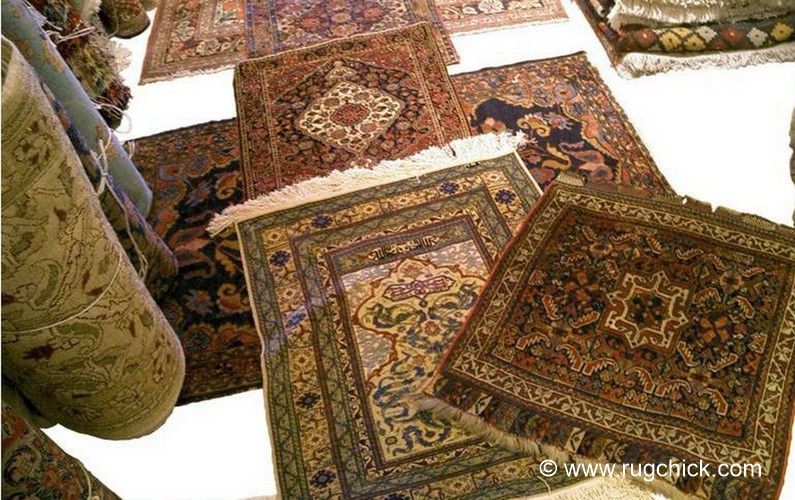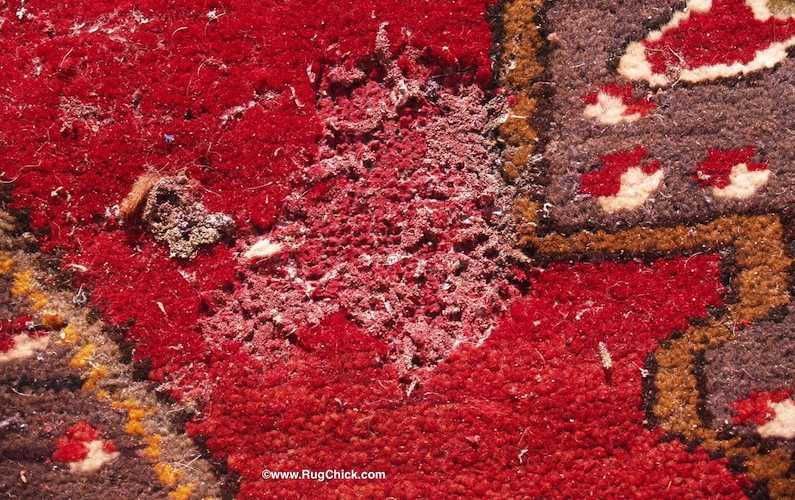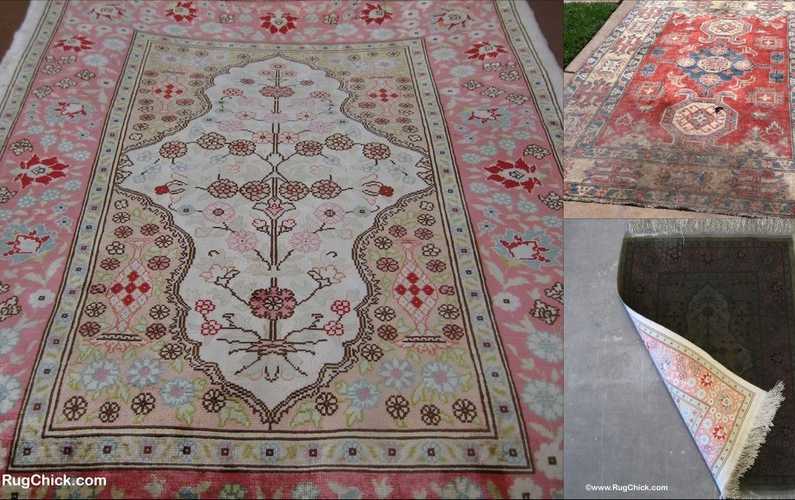Viscose, Bamboo Silk, Banana Silk, Art Silk. What you need to know.
If you are thinking about buying a viscose rug, or viscose furniture, please watch this short video to see what you need to know about this fiber and all of its aliases:
UNDERSTANDING VISCOSE RUGS.
If your designer is strongly recommending viscose to you… have them watch the video with you, and then ask them why they feel this is the best choice for your home.
Rug Makers Are Lying To Consumers And To Designers.
Viscose sheds, breaks, distorts, yellows horribly with even just a water spill (you should see what a pet stain does!), fades, and wears away quickly with even only months of use.
Viscose rugs easily stain and wear down with foot traffic.
Viscose is rayon. It is a fiber made of wood pulp and cellulose waste by-products. These fibers go through an extremely aggressive chemical process to make those fibers soft and shiny. In fact, the rayon making process is so toxic, they stopped all rayon making in the US many years ago. Instead, rug makers have gone to India to do their pollution making.
Here is the FTC’s judgment on banning bamboo-rayon clothing from the US due to false claims on being “eco-friendly” and the harm that the chemicals cause. Click to read the full article.
In the professional cleaning world we call viscose the “sausage of the fiber world.” This is because you don’t want to see how it’s made… and you are not sure what’s really in it when you buy it.
Viscose is being given many names to mislead consumers: art silk (i.e. artificial), bamboo silk, banana silk, manmade silk, lyocel, tencel, and faux silk.
To the uneducated eye, the fibers are very soft, and look silk-like. But where silk is strong and can last decades under use, viscose is one of today’s “disposable fibers” due to how weak it is.
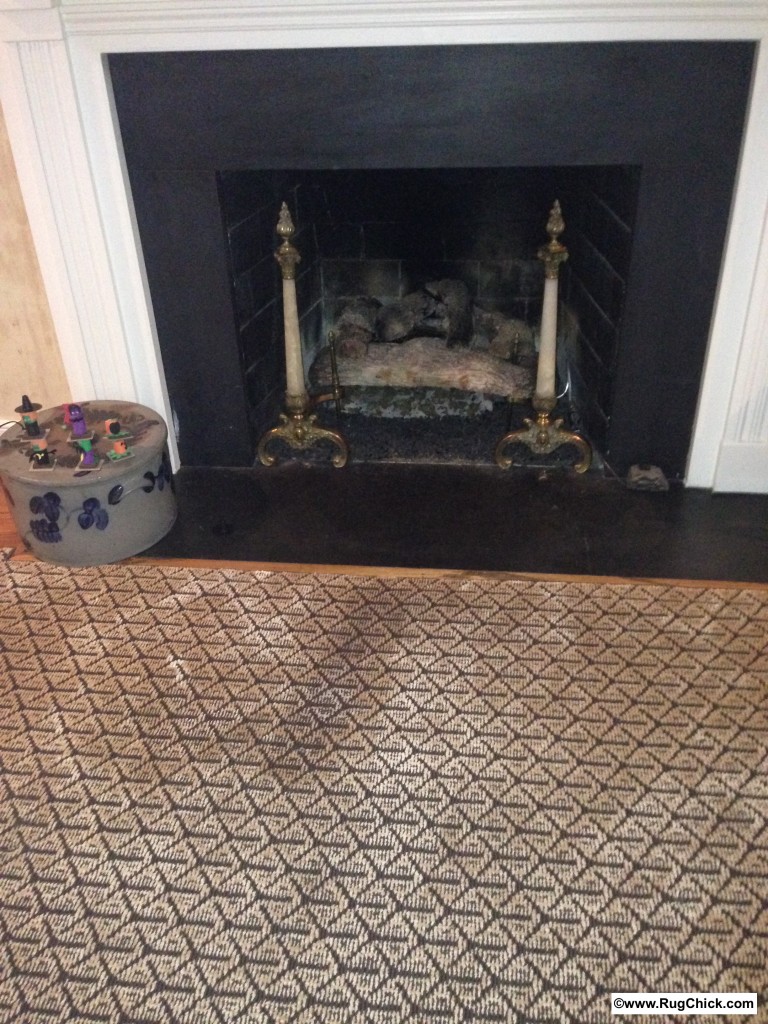
Decorator recommended viscose installed carpeting in the family room. After only a few months of use, clearly a horrible purchase.
Viscose has a unique look and feel. That is true. And if viscose were super cheap, then I would not spend this much time on the topic. That is because everyone would know by the cheap purchase price that it is not meant to last.
However, though the quality of these fibers is cheap, the price to buy them is not. Designer brand name artificial silk is being sold at real silk prices, and that is what makes me upset. Especially when they are implying that it’s real silk and not fake by giving it misleading names like bamboo silk, banana silk, manmade silk, and art silk.
If you are spending thousands of dollars on a rug, it should, in my opinion, last more than a few years, or one spill or two.
My quest is to get rug education out about viscose to every consumer and designer that I can, let them know the TRUTH about these rugs, and then they can make an informed decision to buy it or not.
And when a disaster happens to the rug, which will happen eventually, then the owner will have realistic expectations on what can be done by even by the best professional cleaners. Often replacement will be the solution, and usually with time most viscose owners decide to never buy viscose again.
Here are some things to consider before you place viscose in your home, and some tips in case you decide you must have viscose in your home, to hopefully help it last a bit longer.
APPLY FIBER PROTECTOR IMMEDIATELY.
The only chance of helping to save these rugs from any spill is to have fiber protector applied on day one. This needs to be done by a professional cleaning company and often they apply with different phases in order to allow for quick dry time and the least risk to any texture distortion.
Fiber protectors today provide great repellency to soil and spills/stains. It cannot bullet-proof the fibers, especially viscose, but it does help give you more time to clean up the disaster and hopefully have less signs of it afterwards.
Remember viscose is pricey paper, so anything that can help create some repellency will help the fibers last. I don’t know why every viscose manufacturer does not apply protector before each sale. Well, actually, I do know why. Most sales are “final” and most manufacturers do not want to have your rug last a long time… they want you to have to buy another one. Flawed product means more money for them.
VACUUM VISCOSE VERY CAREFULLY.
With viscose rugs pulls/sprouts are very common. In fact, in most traffic areas it starts to look like a cat clawed at it. You will have thin strands popping up all over. And beater bar vacuums will make this MUCH worse.
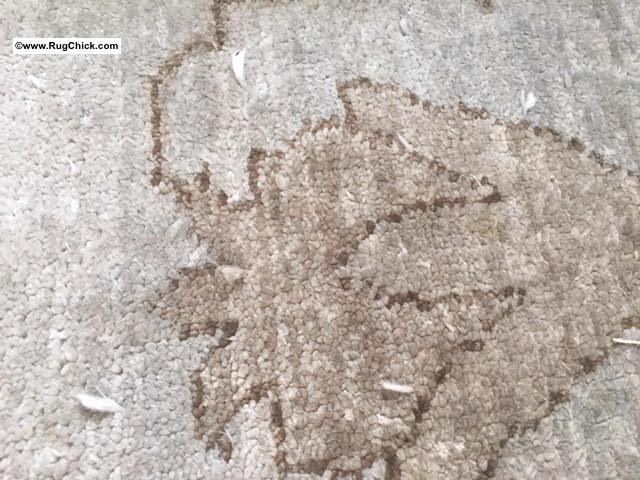
Fiber breaks and pulls is a common problem with viscose rugs.
It is best to vacuum with suction only, and no beater bar on viscose rugs. If even that pulls up too many fibers, then use a hand-held horse hair brush to pick up lint, and a hand-held hose vacuum with a square stair attachment to vacuum the surface.
This is the horse hair brush we like to use to groom all silk and wool rugs, and it’s excellent for helping correct pile distortion on sensitive rugs:
WATER DAMAGE AND PET DAMAGE.
In these instances, your rug is likely a goner. Viscose sitting in water leads to dark yellowing and structural damage. Since water, even “clean water” moves through floors and walls with soil, you usually get dark discolorations from flood damage. The rug will never be back to new again, so unless you plan to place furniture over the damaged area, it would be wise to replace it.
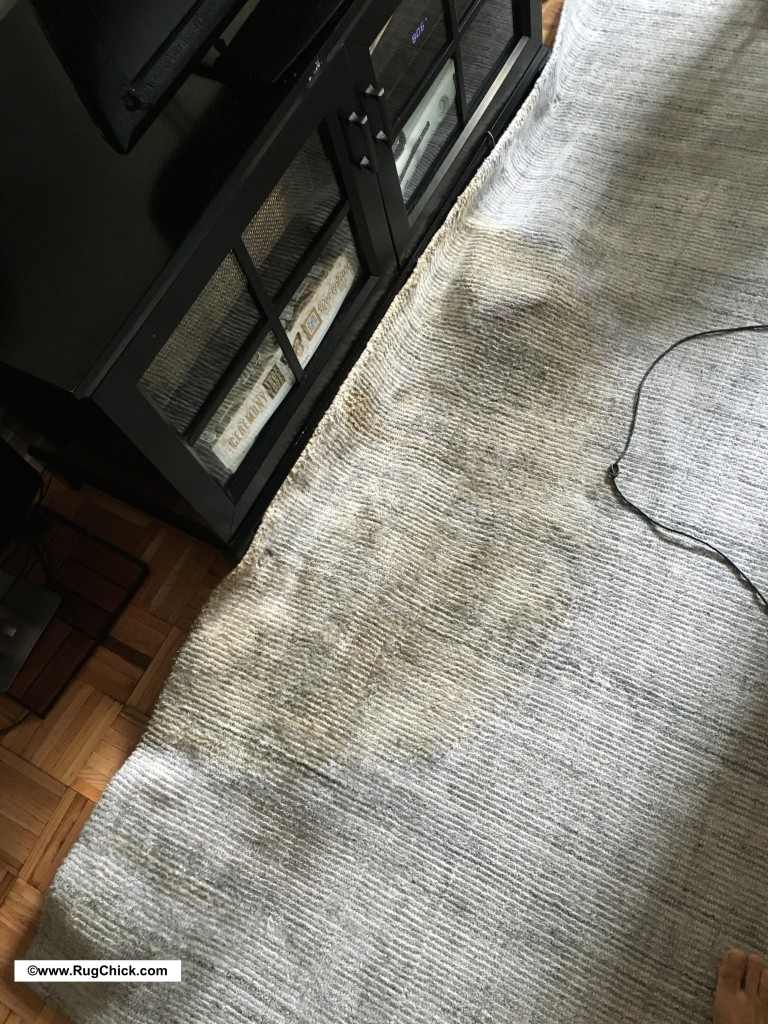
Clean water floods create large yellow discolorations.

Clean water floods create large yellow discolorations.
If the viscose rug sits wet for days, mildew finds viscose as a fantastic food source.
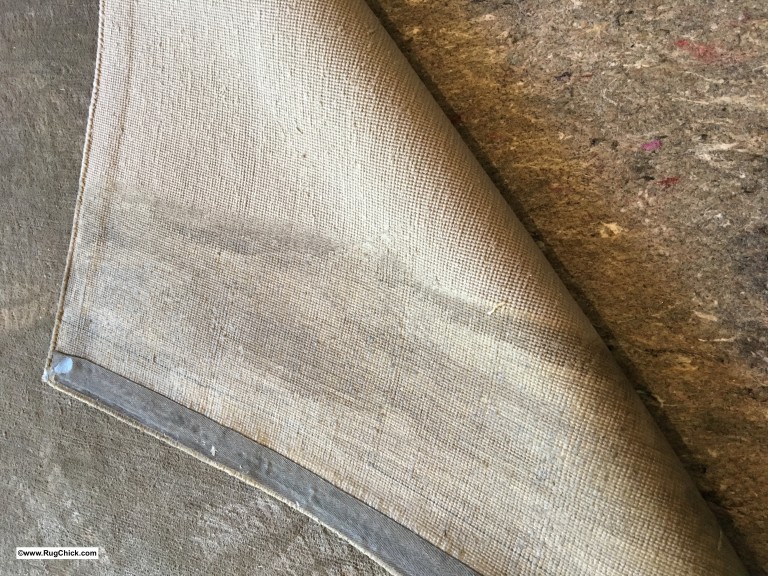
Bamboo silk rug, entire end full of mildew growth.
And pet damage, unless you can get to it immediately (and you have had fiber protector applied to help), that is the most harmful thing that can happen to a rug, but especially so with viscose.
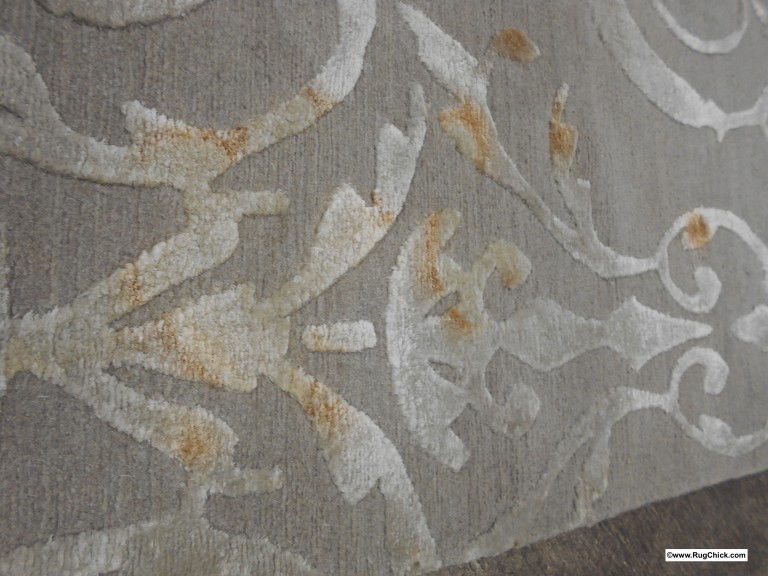
Stains are very difficult to improve on viscose.
Sometimes color correction is possible on viscose, and you need a brave specialist who is willing to try to save your rug for you. (If you need a contact of a professional cleaner in your area, and specifically a dye specialist if you have a stain disaster, send me a note with a photo and where you are located and I can find you someone I know in your area.)
SPILLS. BLOT CAREFULLY & QUICKLY. NEVER SCRUB.
No miracle spot removers. (By the way never use any consumer spot removers on wool either.)
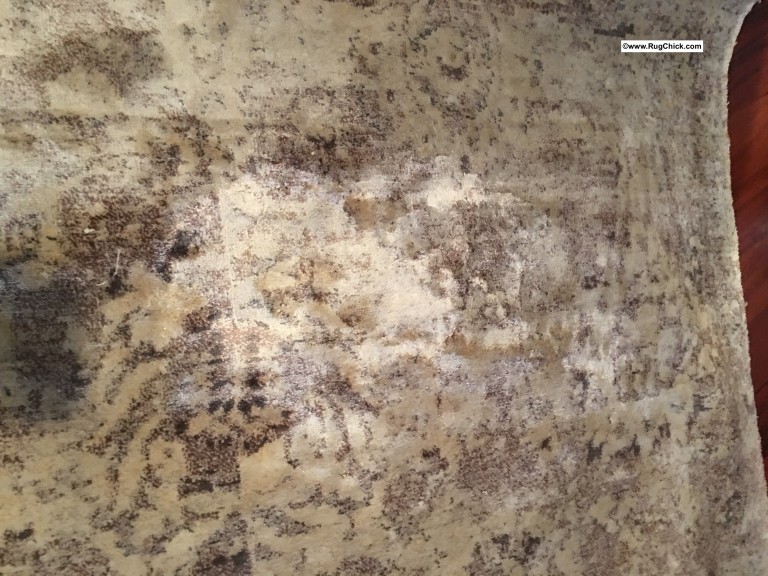
Most consumer spot removers will damage viscose.
If the spill is water, the best choice is to take a cotton white towel, fold it, cover the spill area, and place a heavy weight on it. A gallon of water, a laundry jug, or a kettle bell weight to hold the towel down firmly over the damp area. (If you use a big stack of books please protect your covers from moisture when it wicks up.)
Leave the area alone for 24 hours. Don’t peek or you will halt the absorbent process. Then pick it up and see what is left. The idea is to have all moisture in those fibers move up into the dry cotton and pull the “stuff” up as well. If you have it pressed down then this capillary action works best. Peeking stops it.
If the area is stiff, you can wipe over the surface of this area lightly with a dryer fabric softener sheet, and then take a soft horse hair brush and slowly groom it back into place. The dryer sheet helps break up the surface tension, and the brush helps pick up the fibers. If they start to pull apart when you brush, stop and leave it alone.
If the spill is a drink that needs to be cleaned away, then you will need to mix two parts filtered water to one part white vinegar, take a light-colored sponge (blue sponges can transfer color), get it wet, squeeze out the excess, and carefully dampen the spill area with vinegar water. If you pour it on the area you will ruin the rug, so keep things damp not sopping wet.
Blot with a dry towel (never scrub) to remove excess moisture. I like to stand on the area one last blotting time for good measure. Then lay a dry folded white cotton towel over the spill area and put weight on it for 24 hours.
Same steps if the accident is pet related.
Anything especially large or particularly gross, you are likely buying a new rug. Viscose is very absorbent, and super weak when wet, so if you have a large vomit stain, I don’t see any scenario where you get out of that even with fiber protector and quick action.
MANAGE YOUR EXPECTATIONS.
Remember that viscose is glorified paper.
These are rugs that even brand new, just from rolling and shipping, can create permanent damage that will not come out.
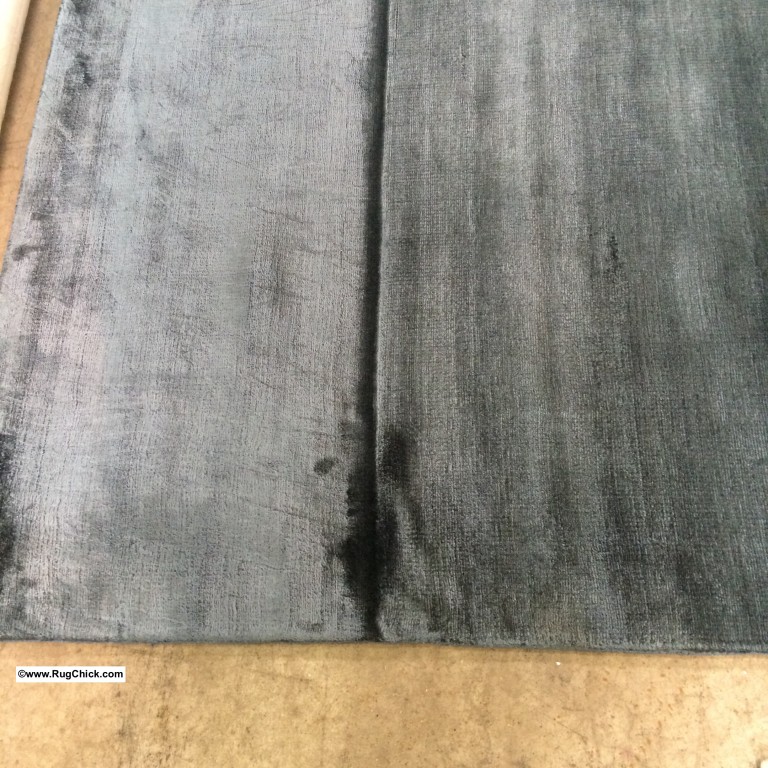
New tencel rug with creases from shipment.
When you cannot even roll the rugs new without problems, I would call that a quality issue.
Therefore, expecting a rug that has been walked on over a year by two kids and two dogs to clean up “just like new” by your professional cleaner is a pipedream.
You need to be prepared to be thrilled with “better than it was.”
Many cleaners will not touch viscose, because it is known to be a flawed fiber. If you find a cleaner willing to take on your cleaning challenge, you should be happy because there are few who will say yes (especially if there are some big problems). I recommend to cleaners to always get a release of liability on viscose rugs and furniture because of the flaws in the product which have nothing to do with their skills.
BUYING “SILK” RUGS: How Do You Know If A Rug Seller Is Lying To You?
Rug stores lying about real silk versus artificial silk is a huge problem today. But here is how you can determine if it is the real thing or not.
Get a sample of the rug before you buy it. There are two ways to fiber test.
1) BURN TEST
Take tweezers and pull out a fiber to test. With a lighter, light it up. Wool and silk are protein fibers that smell like burning hair, and they also self-extinguish. This means the flame will go out. Once cooled off, crush the ash in your fingers and it will crumble. (Synthetic fibers are plastic so they burn into a hard black bead, and if you try to crush it too soon you will melt and burn your fingers so be careful please. It will not crumble.)
Cotton and viscose will burn like paper. It will carry a flame and burn up. It will smell like burning paper. The ash crumbles like burnt paper.
2) WATER TEST
To determine whether a rug is made of mercerized cotton (a high gloss version of regular cotton) or of viscose (the wood pulp and cotton waste by-products production) – you use the water test.
Drop the fibers in a cup of water. Take the tweezers to grab a strand, and if the fiber is cotton it will be STRONGER wet, so pulling on the strand it will stay together. Take your fingers and hold one end, and the tweezers in the other and pull. Cotton will hold.
With viscose, the fiber becomes mush, so as you pull and roll it with your fibers, it pulls apart. It falls apart.
If the sample passes your test, then order the rug. However, just to be safe, test the real rug when you get it, just to make sure they did not send you a good sample but a fake actual rug.
Not implying that some rug makers lie… but… some rug makers do lie.
Recently I have been hearing companies talking about “silk blending” of real silk and cotton. I would assume the only reason they are doing that is to not have the “viscose” name attached to their rugs. And technically with the burn test viscose tests as cotton does, but the water test will tell you the truth of whether it is cotton, or mush.
Any “blend” rugs I would absolutely test the sample on. And if you are not certain, you are welcome to ship me the sample and I will tell you what I see.
Viscose is the most problematic fiber on the rug market today. And these are the rugs with the shortest lives. I have seen rugs that cost tens of thousands of dollars have to be replaced less than a year. I’ve seen it happen several times.
Not once have I seen those rug stores stop carrying those flawed rugs. Why should they? Those margins are great, and there are many new customers to trick into buying them.
And that is how this often happens… being tricked. Told these are great choices for the dining room and family room. Told they are perfect for rooms with kids and pets.
That is the most common scenario I see. Consumer or designers being lied to by the rug makers, or leaving out the particulars, like you can never spill on this rug.
Now, if the rug store tells you the TRUTH. That the fibers are weak. That they do not hold up. That the rug will only look worse with time. And after hearing the truth, you still love the texture and feel and look, and you are good with paying the price. Then good. At least you are fully informed, and you can make that decision for your home with your money.
That is all I want with viscose – some transparency. Then I know I have done my job here as the Rug Chick.
If you have any rugs questions at all, please send me a note. I’d love to hear from you.
Best to you, Lisa
P.S. Sometimes with good washing you can bring a viscose rug back from the brink. Here is one from a flood that came back nicely. Still some yellowing remaining, but treated to remove all mildew odors, and the discoloration improved much better than expected.
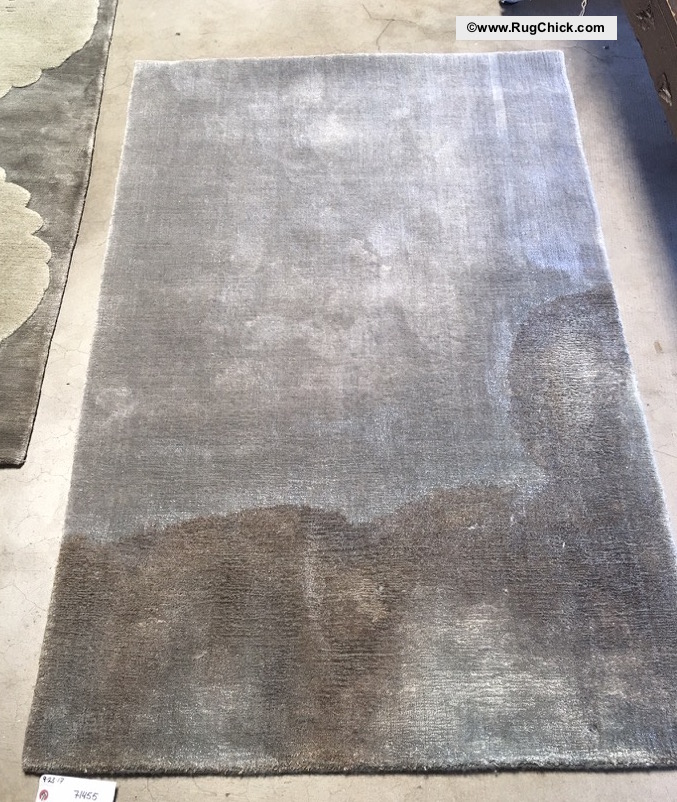
BEFORE – damaged from flood.
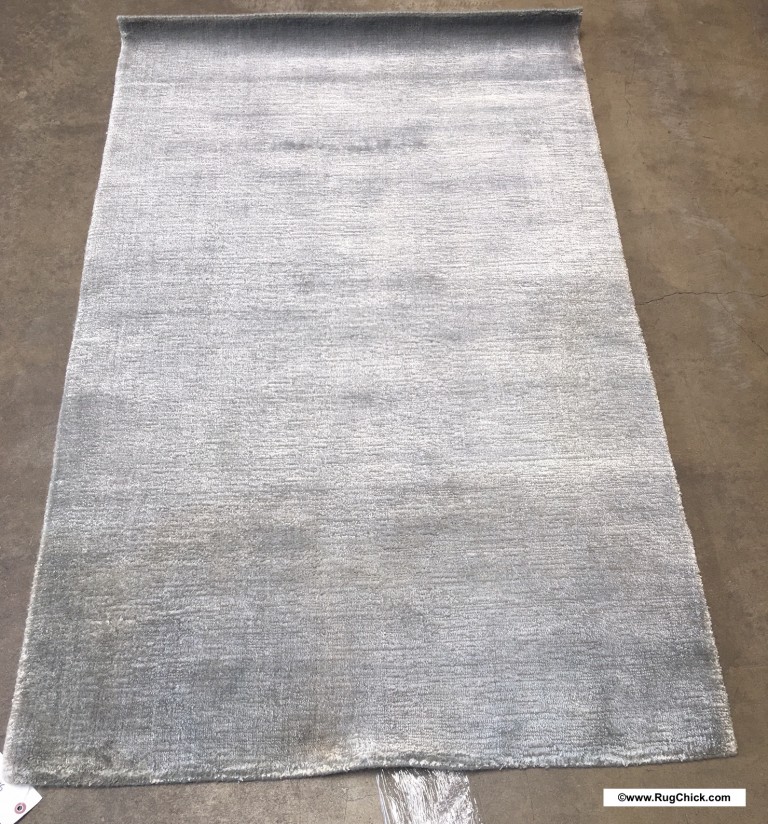
AFTER.


